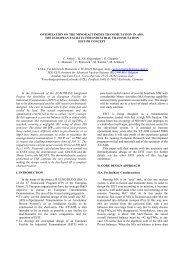AnsaldoEnergia
AnsaldoEnergia - KIT
AnsaldoEnergia - KIT
- No tags were found...
You also want an ePaper? Increase the reach of your titles
YUMPU automatically turns print PDFs into web optimized ePapers that Google loves.
Divisione Nucleare<br />
Progetto<br />
Project<br />
PDS-XADS<br />
<strong>AnsaldoEnergia</strong><br />
Identificativo<br />
Document no.<br />
XADS 20 TRIX 009<br />
Rev.<br />
Rev.<br />
1<br />
Cl. ris.<br />
class<br />
Pagina<br />
Page<br />
43<br />
3.4 FUEL CLADDING CHALLENGES<br />
The first path depicted in Fig. 3.3-1 aims to identify those phenomenologies that have the<br />
potential to affect the integrity of the first physical barrier to the release of the radioactive<br />
fission products to the environment, namely the fuel cladding.<br />
In particular the "FUEL CLADDING CHALLENGES", which are a level 1 of MLD, can be<br />
originated by the following events (level 2 of the MLD):<br />
• POWER ANOMALIES [1.1];<br />
• DECREASE OF FUEL ASSEMBLY HEAT REMOVAL [1.2].<br />
Event [1.1] “POWER ANOMALIES“ refer to anomalies in the power generation leading, in<br />
particular, to an increase in the power generated in the fuel rods. The MLD for these events<br />
will be shown in next section 3.4.1.<br />
Events [1.2] “DECREASE of FUEL ASSEMBLY HEAT REMOVAL” refer to anomalies in the<br />
heat removal process from the fuel cladding that correspond to a decrease of the heat<br />
extracted from the fuel rod. The MLD for these events will be shown in next section 3.4.2.<br />
3.4.1 Power Anomalies<br />
In the XADS the power generated in the fission core is strictly related to the proton beam<br />
current. In particular an almost linear dependence of the generated power from the proton<br />
current intensity exists; thus increasing the proton beam current increases fission power<br />
(while, similarly, decreasing the proton beam current decreases fission power). The proton<br />
current intensity is anticipated to vary along the fuel cycle to compensate the fuel burn up.<br />
Thus “POWER ANOMALIES” in the XADS can be mainly associated to anomalies of the<br />
proton beam current, rather than to reactivity insertion effects which can be considered<br />
“weak”.<br />
The MLD branches detail the event «POWER ANOMALIES», reported in Fig. 3.4-1, identify<br />
three scenarios that have the potential to challenge the fuel clad integrity. They represent<br />
level 3 of the MLD.<br />
level 2 events description<br />
As the MLD shows, the event [1.1] "POWER ANOMALIES” can result from:<br />
DNU 020/1





